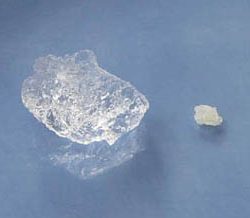Sodium polyacrylate, commonly known as water-absorbing polymer or hydrogel, can absorb a significant amount of water. It has a remarkable ability to absorb and retain water many times its own weight 300-1000 times water. This property makes it useful in various applications such as in industrial wastewater treatment, river dredging, drilling fluid, cable powder, coagulant, dust suppressant, diapers, agriculture (as a soil conditioner), and even in some medical and industrial settings where water absorption is needed.

Several dimensions for measuring the water absorption performance of sodium polyacrylate include:
Water absorption: This refers to how much water Sodium Polyacrylate can absorb, usually measured as multiples of its own weight. For example, it can absorb hundreds of times or more of its own weight in water.
Water Absorption Rate: This refers to how quickly Sodium Polyacrylate absorbs water, i.e. the time it takes from the time it first comes into contact with water to the time it reaches its maximum amount of water absorption. This is critical in certain applications where rapid water absorption is required.
Ability to Release Moisture: Once moisture is absorbed, is Sodium Polyacrylate effective in retaining and releasing the absorbed moisture. This is important in some applications, such as soil amendments used in agriculture that require regular release of water to plants.
Stability: refers to the stability of Sodium Polyacrylate’s water absorption performance under different environmental conditions, such as changes in temperature, pH value, etc. Sodium Polyacrylate with good stability can maintain consistent water absorption performance under various environmental conditions.
Taken together, these dimensions allow a comprehensive assessment of Sodium Polyacrylate’s water absorption properties and determine its applicability, advantages and disadvantages in different fields.

